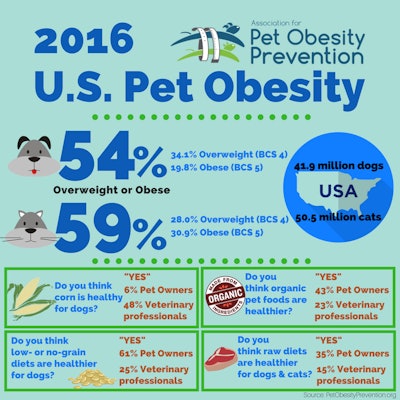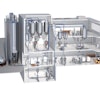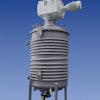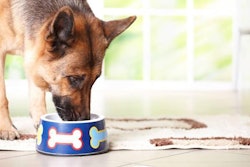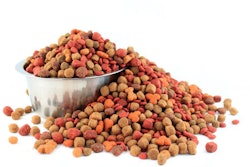
During their ninth annual survey, Association for Pet Obesity Prevention (APOP) researchers found that pet owners and veterinary professionals disagreed on key pet food issues such as the benefits of corn and grains, value of raw and organic diets, and the best sources of pet nutritional advice. APOP’s study also revealed that pet obesity in the US continued to steadily increase in 2016, affecting nearly 59 percent of cats and 54 percent of dogs.
“Obesity continues to be the greatest health threat to dogs and cats,” said APOP founder, veterinarian Dr. Ernie Ward, in a press release. “Obesity is a disease that kills millions of pets prematurely, creates immeasurable pain and suffering, and costs pet owners tens of millions of dollars in avoidable medical costs.”
Pet obesity survey results related to pet food
Quality was the primary influence when purchasing pet food by over 80 percent of pet owners and 82 percent of veterinary staff. Price (16 percent) or location and convenience (7 percent) were not reported as significant factors for either group when choosing food for their dog or cat. Both pet owners and veterinary professionals (55 percent) said they worried about the quality of their pet’s food affecting the long-term health of their dog or cat.
Pet owners and veterinary professionals were sharply divided on pet food ingredients and types of dog and cat diets.
- Do you think low- or no-grain diets are healthier for dogs?
- 61 percent pet owners and 25 percent veterinary professionals agreed with this statement
- Do you think raw diets are healthier for dogs and cats?
- 35 percent pet owners and 15 percent veterinary professionals agreed
- Do you think organic pet foods are healthier?
- 43 percent pet owners and 23 percent veterinary professionals agreed
- Do you think corn is healthy for dogs?
- 73 percent of pet owners disagreed while 48 percent veterinary professionals agreed
Only 42 percent of pet owners agreed their veterinarian should recommend a maintenance diet, compared to over 64 percent of veterinarians. Only 39 percent of pet owners recalled their veterinary clinic recommended a maintenance diet, while about 48 percent of veterinary professionals stated they offered routine diet recommendations.
When asked where they obtained the best sources of dietary recommendations for their pet, over 46 percent of pet owners rated online advice as the best method, compared to 19 percent of veterinary professionals.
Dog and cat obesity in 2016
In the October 2016 clinical survey, 53.9 percent of dogs and 58.9 percent of cats were classified as overweight (body condition score (BCS) 4) or obese (BCS 5) by their veterinary healthcare professional. That equals an estimated 41.9 million dogs and 50.5 million cats that are too heavy, based on 2016 pet population projections provided by the American Pet Products Association (APPA). In 2015, APOP found 53.8 percent of dogs and 58.2 percent were overweight or obese.
Pet owners and veterinary professionals were questioned about pet obesity, diet and nutrition, and sources of pet food advice. When asked to classify their own pet’s weight, 81 percent of pet owners and 87 percent of veterinary professionals reported they were a normal and healthy weight. 98 percent of veterinary clinic staff agreed that pet obesity was a problem in the US, compared to about 87 percent of pet owners. Nearly all pet owners and veterinary professionals (greater than 95 percent) believed an overweight pet is at increased risk of pain and suffering and that quality nutrition can extend life expectancy.
